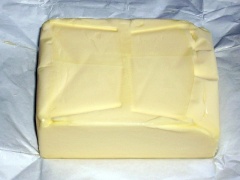Butter
| Infobox on Butter | |
|---|---|
| Example of Butter |  |
| Facts | |
| Origin | This Table shows only a selection of the most important countries of origin and should not be thought of as exhaustive.
|
| Stowage factor (in m3/t) |
|
| Angle of repose | - |
| Humidity / moisture |
|
| Oil content | Butter consists of the following constituents:
|
| Ventilation | 15 - 20 circulations/hour without supply of fresh air in order to ensure uniform cooling of the cargo. Fresh air should not be supplied in order to avoid any possible increase in temperature and the introduction of microorganisms into the storage compartments. |
| Risk factors |
|
Butter
Description
The cream for butter-making is pasteurized at above 90°C to inactivate enzymes and to reduce the number of microorganisms which would otherwise cause quality loss. Butter is an emulsion of water and oil (fat).
There are generally two varieties of butter:
- Sweet cream butter
- Sour cream (lactic) butter
which can only be easily distinguished organoleptically from one another.
The salt content may vary from 0,5 to 1,5% or even higher in those countries where salt is popular. However, butter is also shipped in unsalted form. Butter is normally packed in bulk, in 25 kg blocks, wrapped in polythene or vegetable parchment, and placed in corrugated fibreboard cases, sealed with adhesive tape, also packed in foil or parchment wrapped packets in corrugated fibreboard cases. Small quantities of butter are also packed in cans of various sizes.
The choice of inner bulk wrap, plastic or parchment, is important as the use of a poor quality wrap will increase the rate of development of surface deterioration. Packaging should be in close contact with the butter so as to exclude air from the surface which will lead to oxidation problems. Apart from the surface effect, the outer carton has little influence on the keeping quality except to prevent access of absorbed taints. Butter should not be stored with products having a strong odor, such as fuel oil, fruit etc.
Applications
Butter is generally used as a spread and a condiment, as well as in cooking, such as baking, sauce making, and pan frying.
Shipment/storage
Although butter microbiologically is fairly stable, chemically it is less stable and for this reason it must be held < -12°C during long(er) storage and shipment. Provided there is no fault in the butter at the time of production, damage to butter in transit is most often caused by temperature fluctuation. There is a progressive increase in the rate of deterioration with rise in temperature, leading to condensation of moisture on the wrapper and mold development. The presence of mold will be evident by the development of surface growths, bright red stains, blackish spots spreading to brown stains, green surface growths, etc. If there is gross mold growth, the butter and atmosphere will be characterized with a musty odor. Poor storage conditions and inferior packaging can also contribute to mold growth. The presence of salt or lactic acid inhibits the growth of yeasts, mold and bacteria.
The growth of micro-organisms and the action of atmospheric oxygen give rise to off-flavors which can render the butter inedible. Ultra violet light has a pre-oxidative effect and also increases the rate of development of tallowy off-flavours and as such bulk butter without wrapping should not be exposed to daylight for long periods.
Butter packed in cans is quite stable at temperatures up to about 20°C. Above this temperature melting might occur, which destroys the texture and may affect the flavor.
Pallet loads of butter which have been shrink wrapped suffer less damage as condensation forms on the wrap and the cases are protected. If cartooned butter is subjected, while in transit, to fire, smoke, etc., it is likely that a taint will occur and the most probable entry is through the seam of the outer carton.
Temperature
At normal temperatures, butter is subject to microbiological deterioration.
Butter may be transported either frozen or chilled.
Frozen butter:
Recommended carriage temperature -18°C (8-12 months storage potential).
Chilled butter:
Recommended carriage temperature): -1 to 4°C (1-2 months storage potential). The melting point of butter is 20 to 25°C.
At temperatures > 8°C, distortion of the product may occur. At temperatures < 0°C, losses in quality (crumbly texture) may occur.











